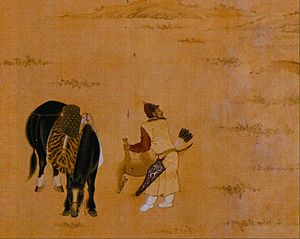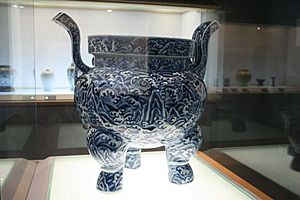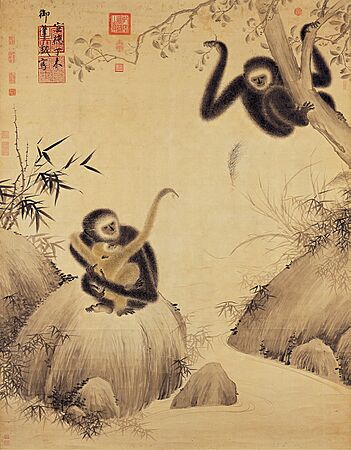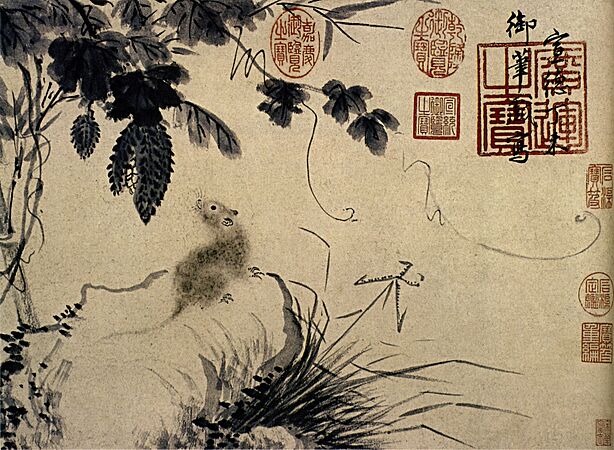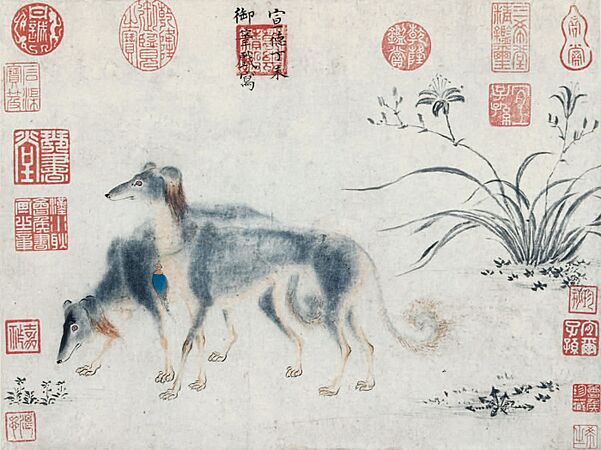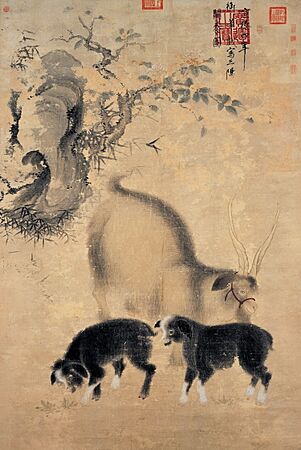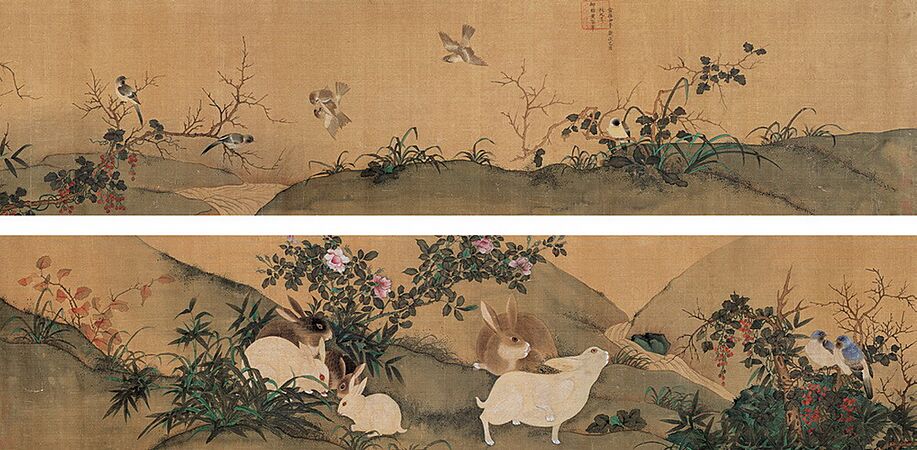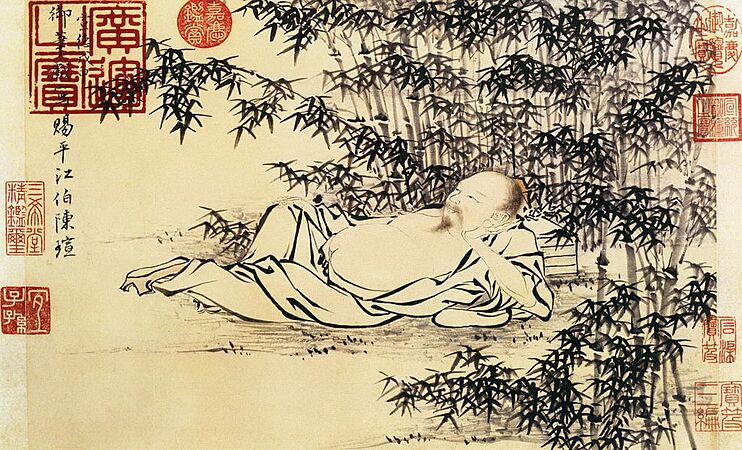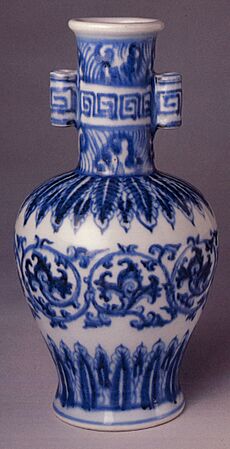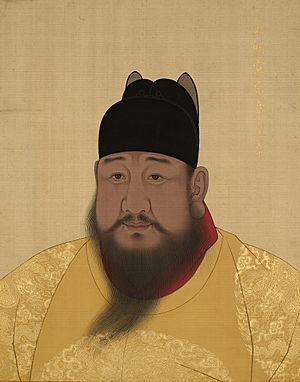Xuande Emperor facts for kids
Quick facts for kids Xuande Emperor宣德帝 |
|||||||||||||||||
|---|---|---|---|---|---|---|---|---|---|---|---|---|---|---|---|---|---|
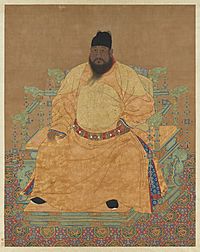
|
|||||||||||||||||
| 5th Emperor of the Ming dynasty | |||||||||||||||||
| Reign | 27 June 1425 – 31 January 1435 | ||||||||||||||||
| Enthronement | 27 June 1425 | ||||||||||||||||
| Predecessor | Hongxi Emperor | ||||||||||||||||
| Successor | Emperor Yingzong (Zhengtong Emperor) |
||||||||||||||||
| Crown Prince of the Ming dynasty | |||||||||||||||||
| Tenure | 1 November 1424 – 27 June 1425 | ||||||||||||||||
| Predecessor | Crown Prince Zhu Gaochi | ||||||||||||||||
| Successor | Crown Prince Zhu Qizhen | ||||||||||||||||
| Imperial Grandson-heir of the Ming dynasty along with Crown Prince Zhu Gaochi from 1411 |
|||||||||||||||||
| Tenure | 1411–1424 | ||||||||||||||||
| Predecessor | Imperial Grandson-heir Zhu Yunwen | ||||||||||||||||
| Successor | None (as the last imperial grandson-heir of China) | ||||||||||||||||
| Born | 16 March 1399 Hongwu 32, 9th day of the 2nd month (洪武三十二年二月初九日) Beijing, Ming dynasty |
||||||||||||||||
| Died | 31 January 1435 (aged 35) Xuande 10, 3rd day of the 1st month (宣德十年正月初三日) Palace of Heavenly Purity, Forbidden City, Beijing, Ming dynasty |
||||||||||||||||
| Burial | Jingling Mausoleum, Ming tombs, Beijing | ||||||||||||||||
| Consorts |
|
||||||||||||||||
| Issue |
|
||||||||||||||||
|
|||||||||||||||||
| House | House of Zhu | ||||||||||||||||
| Dynasty | Ming dynasty | ||||||||||||||||
| Father | Hongxi Emperor | ||||||||||||||||
| Mother | Empress Chengxiaozhao | ||||||||||||||||
| Xuande Emperor | |||||||||||||||||||||||||
|---|---|---|---|---|---|---|---|---|---|---|---|---|---|---|---|---|---|---|---|---|---|---|---|---|---|
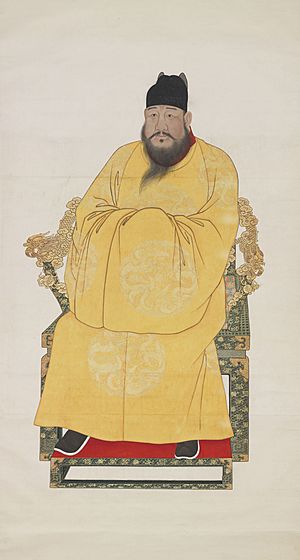 |
|||||||||||||||||||||||||
| Chinese | 宣德帝 | ||||||||||||||||||||||||
|
|||||||||||||||||||||||||
The Xuande Emperor (born Zhu Zhanji) was the fifth Emperor of the Ming dynasty. He ruled from 1425 to 1435. His special name, "Xuande," means "proclamation of virtue." He was known for being a good ruler during a peaceful time in the Ming dynasty. He also loved painting and writing. The emperor helped farmers by lowering taxes and tried to stop corruption. He also allowed Zheng He to go on his last big sea journey.
Contents
Early Life and Reign
Zhu Zhanji was born on March 16, 1399. He was the oldest son of the Hongxi Emperor and Empress Chengxiaozhao. People believed he would be a great leader. His grandfather, the Yongle Emperor, had high hopes for him.
Xuande loved poetry and literature. Even though he called Beijing a "secondary capital," he lived there and ruled from it, just like his grandfather.
Dealing with Challenges
The Xuande Emperor faced a challenge from his uncle, Zhu Gaoxu, Prince of Han. Zhu Gaoxu had been a favorite of the Yongle Emperor because of his military skills. However, he often disobeyed orders. In 1417, he was sent away to a small area called Le'an in Shandong.
When Zhu Gaoxu started a rebellion, the Xuande Emperor quickly led 20,000 soldiers to attack him. Zhu Gaoxu surrendered soon after. He was no longer a prince. Many officials who joined the rebellion were punished. The emperor did not want to harm his uncle at first. However, Zhu Gaoxu's actions later angered the emperor, and he was punished.
Foreign Relations
In 1428, the Xuande Emperor gave the King of Chūzan (in what is now Okinawa, Japan) a new family name, Shang. He also gave him the title "King of Ryūkyū." This showed good relations between the Ming dynasty and the Ryukyu Kingdom.
The emperor wanted to pull his troops out of Việt Nam. Some of his advisors disagreed. After many Ming soldiers were lost, the emperor sent another army. But this army was also defeated by the Vietnamese. The Ming forces left, and the Xuande Emperor finally agreed that Việt Nam should be independent.
In the north, the Xuande Emperor checked the border in 1428. He used 3,000 cavalry troops to fight back against a raid by the Mongols. The Ming government also had good relations with the Oirat tribes after they defeated another Mongol group. China's relations with Japan also got better in 1432.
Government Reforms
During Xuande's rule, a group of trusted eunuchs (palace officials) gained more power. They helped the emperor control the Jinyiwei (secret police).
In 1428, the emperor replaced a corrupt official named Liu Guan with an honest one, Gu Zuo. Gu Zuo removed many officials who were not doing their jobs well. The emperor also changed rules for military service and how to treat soldiers who left their posts. However, the army still had problems.
For many years, farmers faced unfair taxes. In 1430, the Xuande Emperor lowered taxes on royal lands. He also sent officials to the provinces to improve how things were run. These officials tried to stop corruption among tax collectors. The emperor often ordered new trials for people, which helped thousands of innocent people go free.
A Golden Age
The Xuande Emperor died in 1435 after ruling for ten years. His time as emperor was very peaceful. There were no major problems inside or outside China. Later historians often say his reign was the best time, or "golden age," of the Ming dynasty.
Even with his good changes, the Xuande Emperor also enjoyed luxury. He sent officials to find entertainers for his palace. He also gave more power to eunuchs. He even created a special school for them.
The Emperor as an Artist
The Xuande Emperor was a very talented painter. He was especially good at painting animals. Some of his artworks are kept in the National Palace Museum in Taipei. Others are in the Harvard Art Museums in the United States. A museum expert, Robert D. Mowry, said he was "the only Ming emperor who displayed genuine artistic talent and interest."
The time of the Xuande Emperor is also famous for its beautiful Chinese Blue and White porcelain. These crafts were very detailed and special.
Artistic Works
-
Gibbons at play (戲猿圖; 1427), National Palace Museum, Taipei, Taiwan
-
Mouse and Stone (苦瓜鼠圖; 1427), The Palace Museum, Beijing
-
Two Saluki Hounds (猎犬圖; 1427), Harvard Art Museum, United States
-
Marquis Wu in Repose (武侯高臥圖), The Palace Museum
-
Ming dynasty Xuande mark and period (1426–35) imperial blue and white vase. The Metropolitan Museum of Art, New York.
Portrayal in Art
Family
Wives and Children:
- Empress Gongrangzhang, of the Hu clan (born 1402 – died 1443)
- Princess Shunde (born 1420–died 1443)
- Married Shi Jing in 1437
- Princess Yongqing (died 1433)
- Princess Shunde (born 1420–died 1443)
- Empress Xiaogongzhang, of the Sun clan (born 1399–died 1462)
- Princess Changde (born 1424–died 1470)
- Married Xue Huan in 1440
- Zhu Qizhen, Emperor Yingzong (born 1427 – died 1464)
- Princess Changde (born 1424–died 1470)
- Consort Rongsixian, of the Wu clan (born 1397 – died 1462)
- Zhu Qiyu, the Jingtai Emperor (born 1428 – died 1457)
- Noble Consort Duanjing, of the He clan (died 1435)
- Consort Chunjingxian, of the Zhao clan (died 1435)
- Consort Zhenshunhui, of the Wu clan (died 1435)
- Consort Zhuangjingshu, of the Jiao clan (died 1435)
- Consort Zhuangshunjing, of the Cao clan (died 1435)
- Consort Zhenhuishun, of the Xu clan (died 1435)
- Consort Gongdingli, of the Yuan clan (died 1435)
- Consort Zhenjinggong, of the Zhu clan (died 1435)
- Consort Gongshunchong, of the Li clan (died 1435)
- Consort Suxicheng, of the He clan (died 1435)
- Consort Shu, of the Liu clan
- Concubine Zhen'aiguo, of the Guo clan (died 1435)
- Lady Gongshen, of the Korean Cheongju Han clan (born 1410 – died 1483)
Popular Culture
- Portrayed by Zhu Yawen in the 2019 Hunan TV series Ming Dynasty.
- Portrayed by Xu Kai in the 2022 Hunan/Mango TV series Royal Feast "尚食".
See also
 In Spanish: Xuande para niños
In Spanish: Xuande para niños
- Chinese emperors family tree (late)



